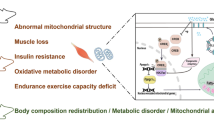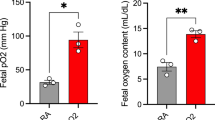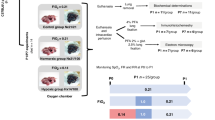Abstract
We hypothesized that maternal creatine supplementation from mid-pregnancy would protect the diaphragm of the newborn spiny mouse from the effects of intrapartum hypoxia. Pregnant mice were fed a control or 5% creatine-supplemented diet from mid-gestation. On the day before term, intrapartum hypoxia was induced by isolating the pregnant uterus in a saline bath for 7.5–8 min before releasing and resuscitating the fetuses. Surviving pups were placed with a cross-foster dam, and diaphragm tissue was collected at 24 h postnatal age. Hypoxia caused a significant decrease in the cross-sectional area (∼19%) and contractile function (26.6% decrease in maximum Ca2+-activated force) of diaphragm fibers. The mRNA levels of the muscle mass-regulating genes MuRF1 and myostatin were significantly increased (2-fold). Maternal creatine significantly attenuated hypoxia-induced fiber atrophy, contractile dysfunction, and changes in mRNA levels. This study demonstrates that creatine loading before birth significantly protects the diaphragm from hypoxia-induced damage at birth.
Similar content being viewed by others
Log in or create a free account to read this content
Gain free access to this article, as well as selected content from this journal and more on nature.com
or
Abbreviations
- CSA:
-
Cross-sectional area
- PCr:
-
phosphocreatine
- TCr:
-
total creatine
References
Low JA 2004 Determining the contribution of asphyxia to brain damage in the neonate. J Obstet Gynaecol Res 30: 276–286
Graham EM, Ruis KA, Hartman AL, Northington FJ, Fox HE 2008 A systemic review of the role of intrapartum hypoxia-ischemia in the causation of neonatal encephalopathy. Am J Obstet Gynecol 199: 587–595
Perlman JM, Tack ED, Martin T, Shackelford G, Amon E 1989 Acute systemic organ injury in term infants after asphyxia. Am J Dis Child 143: 617–620
Siew ML, Wallace MJ, Kitchen MJ, Lewis RA, Fouras A, Te Pas AB, Yagi N, Uesugi K, Siu KK, Hooper SB 2009 Inspiration regulates the rate and temporal pattern of lung liquid clearance and lung aeration at birth. J Appl Physiol 106: 1888–1895
Wright VP, Klawitter PF, Iscru DF, Merola AJ, Clanton TL 2005 Superoxide scavengers augment contractile but not energetic responses to hypoxia in rat diaphragm. J Appl Physiol 98: 1753–1760
Allen DG, Lamb GD, Westerblad H 2008 Skeletal muscle fatigue: cellular mechanisms. Physiol Rev 88: 287–332
Nagasawa T, Hatayama T, Watanabe Y, Tanaka M, Niisato Y, Kitts DD 1997 Free radical-mediated effects on skeletal muscle protein in rats treated with Fe-nitrilotriacetate. Biochem Biophys Res Commun 231: 37–41
Simpson JA, van Eyk JE, Iscoe S 2000 Hypoxemia-induced modification of troponin I and T in canine diaphragm. J Appl Physiol 88: 753–760
Mohanraj P, Merola AJ, Wright VP, Clanton TL 1998 Antioxidants protect rat diaphragmatic muscle function under hypoxic conditions. J Appl Physiol 84: 1960–1966
Ottenheijm CA, Heunks LM, Geraedts MC, Dekhuijzen PN 2006 Hypoxia-induced skeletal muscle fiber dysfunction: role for reactive nitrogen species. Am J Physiol Lung Cell Mol Physiol 290: L127–L135
Hoppeler H, Kleinert E, Schlegel C, Claassen H, Howald H, Kayar SR, Cerretelli P 1990 Morphological adaptations of human skeletal muscle to chronic hypoxia. Int J Sports Med 11: S3–S9
Caron MA, Theriault ME, Pare ME, Maltais F, Debigare R 2009 Hypoxia alters contractile protein homeostasis in L6 myotubes. FEBS Lett 583: 1528–1534
Russell AP 2010 The molecular regulation of skeletal muscle mass. Clin Exp Pharmacol Physiol 37: 378–384
Ireland Z, Dickinson H, Snow R, Walker DW 2008 Maternal creatine: does it reach the fetus and improve survival after an acute hypoxic episode in the spiny mouse (Acomys cahirinus)?. Am J Obstet Gynecol 198: 431.e1–431.e6
Ireland Z, Dickinson H, Fleiss B, Hutton LC, Walker DW 2010 Behavioural effects of near-term acute fetal hypoxia in a small precocial animal, the spiny mouse (Acomys cahirinus). Neonatology 97: 45–51
Snow RJ, Murphy RM 2001 Creatine and the creatine transporter: a review. Mol Cell Biochem 224: 169–181
Lawler JM, Barnes WS, Wu G, Song W, Demaree S 2002 Direct antioxidant properties of creatine. Biochem Biophys Res Commun 290: 47–52
Murphy RM, Stephenson DG, Lamb GD 2004 Effect of creatine on contractile force and sensitivity in mechanically skinned single fibers from rat skeletal muscle. Am J Physiol Cell Physiol 287: C1589–C1595
Hespel P, Op't Eijnde B, Van Leemputte M, Urso B, Greenhaff PL, Labarque V, Dymarkowski S, Van Hecke P, Richter EA 2001 Oral creatine supplementation facilitates the rehabilitation of disuse atrophy and alters the expression of muscle myogenic factors in humans. J Physiol 536: 625–633
Deldicque L, Theisen D, Bertrand L, Hespel P, Hue L, Francaux M 2007 Creatine enhances differentiation of myogenic C2C12 cells by activating both p38 and Akt/PKB pathways. Am J Physiol Cell Physiol 293: C1263–C1271
D'Udine B, Alleva E 1988 The Acomys cahirinus (spiny mouse) as a new model for biological and neurobehavioural studies. Pol J Pharmacol Pharm 40: 525–534
Dickinson H, Walker DW 2007 Managing a colony of spiny mice (Acomys cahirinus) for perinatal research. ANZCCART News 20: 4–11
Brooke MH, Kaiser KK 1970 Muscle fiber types: how many and what kind?. Arch Neurol 23: 369–379
West JM, Barclay CJ, Luff AR, Walker DW 1999 Developmental changes in the activation properties and ultrastructure of fast- and slow-twitch muscles from fetal sheep. J Muscle Res Cell Motil 20: 249–264
Cannata DJ, Finkelstein DI, Gantois I, Teper Y, Drago J, West JM 2009 Altered fast- and slow-twitch muscle fibre characteristics in female mice with a (S248F) knock-in mutation of the brain neuronal nicotinic acetylcholine receptor. J Muscle Res Cell Motil 30: 73–83
Ashley CC, Moisescu DG 1977 Effect of changing the composition of the bathing solutions upon the isometric tension-pCa relationship in bundles of crustacean myofibrils. J Physiol 270: 627–652
Bortolotto SK, Cellini M, Stephenson DG, Stephenson GM 2000 MHC isoform composition and Ca(2+)- or Sr(2+)-activation properties of rat skeletal muscle fibers. Am J Physiol Cell Physiol 279: C1564–C1577
Lundby C, Nordsborg N, Kusuhara K, Kristensen KM, Neufer PD, Pilegaard H 2005 Gene expression in human skeletal muscle: alternative normalization method and effect of repeated biopsies. Eur J Appl Physiol 95: 351–360
De Bock K, Richter EA, Russell AP, Eijnde BO, Derave W, Ramaekers M, Koninckx E, Leger B, Verhaeghe J, Hespel P 2005 Exercise in the fasted state facilitates fibre type-specific intramyocellular lipid breakdown and stimulates glycogen resynthesis in humans. J Physiol 564: 649–660
Glass DJ 2003 Molecular mechanisms modulating muscle mass. Trends Mol Med 9: 344–350
Levine S, Tikunov B, Henson D, LaManca J, Sweeney HL 1996 Creatine depletion elicits structural, biochemical, and physiological adaptations in rat costal diaphragm. Am J Physiol 271: C1480–C1486
Launay T, Hagstrom L, Lottin-Divoux S, Marchant D, Quidu P, Favret F, Duvallet A, Darribere T, Richalet JP, Beaudry M 2010 Blunting effect of hypoxia on the proliferation and differentiation of human primary and rat L6 myoblasts is not counteracted by Epo. Cell Prolif 43: 1–8
Ottenheijm CA, Heunks LM, Li YP, Jin B, Minnaard R, van Hees HW, Dekhuijzen PN 2006 Activation of the ubiquitin-proteasome pathway in the diaphragm in chronic obstructive pulmonary disease. Am J Respir Crit Care Med 174: 997–1002
Smith LR, Ponten E, Hedstrom Y, Ward SR, Chambers HG, Subramaniam S, Lieber RL 2009 Novel transcriptional profile in wrist muscles from cerebral palsy patients. BMC Med Genomics 2: 44
Louis M, Van Beneden R, Dehoux M, Thissen JP, Francaux M 2004 Creatine increases IGF-I and myogenic regulatory factor mRNA in C(2)C(12) cells. FEBS Lett 557: 243–247
Sacheck JM, Ohtsuka A, McLary SC, Goldberg AL 2004 IGF-I stimulates muscle growth by suppressing protein breakdown and expression of atrophy-related ubiquitin ligases, atrogin-1 and MuRF1. Am J Physiol Endocrinol Metab 287: E591–E601
van Loon LJ, Oosterlaar AM, Hartgens F, Hesselink MK, Snow RJ, Wagenmakers AJ 2003 Effects of creatine loading and prolonged creatine supplementation on body composition, fuel selection, sprint and endurance performance in humans. Clin Sci (Lond) 104: 153–162
Godt RE, Nosek TM 1989 Changes of intracellular milieu with fatigue or hypoxia depress contraction of skinned rabbit skeletal and cardiac muscle. J Physiol 412: 155–180
Casey A, Constantin-Teodosiu D, Howell S, Hultman E, Greenhaff PL 1996 Creatine ingestion favorably affects performance and muscle metabolism during maximal exercise in humans. Am J Physiol 271: E31–E37
Brosnan JT, Brosnan ME 2007 Creatine: endogenous metabolite, dietary and therapeutic supplement. Annu Rev Nutr 27: 241–261
Author information
Authors and Affiliations
Corresponding author
Additional information
Supported by grants from the National Health and Medical Research Council (NHMRC) of Australia [to R.J.S. and D.W.W.]. A.P.R. is supported by an NHMRC Biomedical Career Development Award (479536). D.J.C. was supported by a graduate scholarship from the School of Life and Environmental Sciences, Deakin University.
Rights and permissions
About this article
Cite this article
Cannata, D., Ireland, Z., Dickinson, H. et al. Maternal Creatine Supplementation From Mid-Pregnancy Protects the Diaphragm of the Newborn Spiny Mouse From Intrapartum Hypoxia-Induced Damage. Pediatr Res 68, 393–398 (2010). https://doi.org/10.1203/PDR.0b013e3181f1c048
Received:
Accepted:
Issue date:
DOI: https://doi.org/10.1203/PDR.0b013e3181f1c048
This article is cited by
-
The creatine kinase system and pleiotropic effects of creatine
Amino Acids (2011)



